radiator cap PONTIAC GRAND-PRIX 1993 Owners Manual
[x] Cancel search | Manufacturer: PONTIAC, Model Year: 1993, Model line: GRAND-PRIX, Model: PONTIAC GRAND-PRIX 1993Pages: 338, PDF Size: 17.3 MB
Page 195 of 338
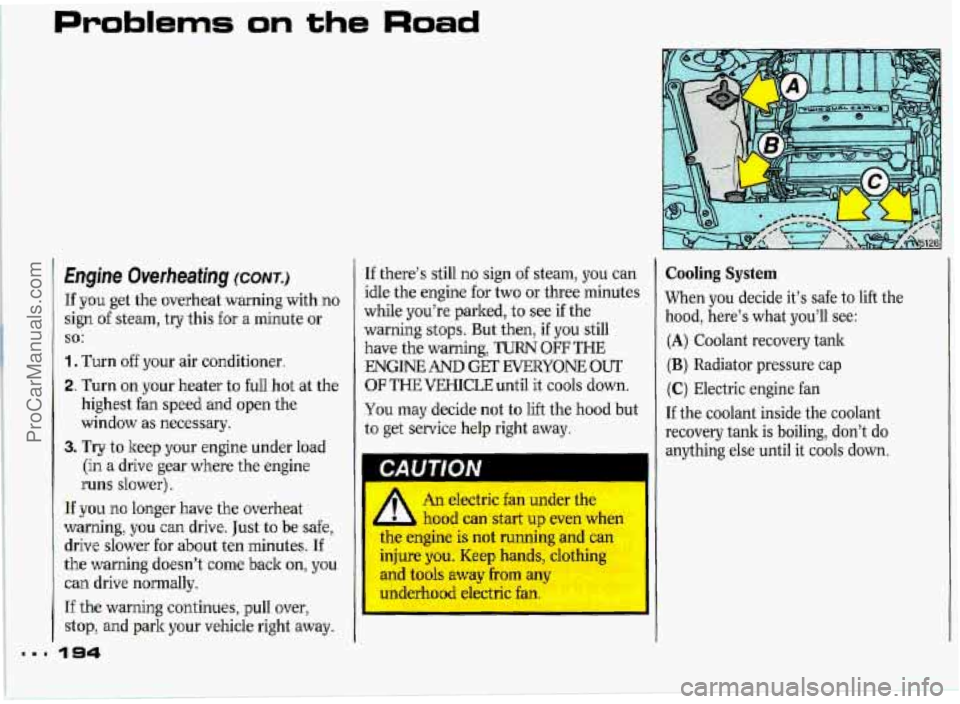
Problems on the Road
Engine Overheafing ICONT.)
If you get the overheat warning with no
sign
of steam, try this for a minute or
1. Turn off your air conditioner.
2. Turn on your heater to full hot at the
SO:
highest fan speed and open the
window as necessary.
3. Try to keep your engine under load
(in a drive gear where the engine
runs slower).
If you no longer have the overheat
warning,
you can drive. Just to be safe,
drive slower for about ten minutes. If
the warning doesn’t come back
on, you
can drive normally.
If the warning continues, pull over, If
there’s still
no sign of steam, you can
idle
the engine for two or three minutes
while you’re parked, to
see if the
warning
stops. But then, if you still
have the warning,
TURN OFF THE
ENGINEANDGETEVERYONEOUT
OF THE IrEp3[1CLE until it cools down.
You may decide not to lift the hood but
to get servioe
help right away.
a
An electric fan under the
L L hood can start up even when
the engine
is not running and can
injure you. Keep hands, clothing
and tools away from any
underhood electric fan. I
stop, and park your vehicle right away. I I
Cooling System
When you decide it’s safe to lift the
hood, here’s what you’ll see:
(A) Coolant recovery tank
(B) Radiator pressure cap
(C) Electric engine fan
If the coolant inside the coolant
recovery tank is boiling, don’t do
anything else until it cools down.
ProCarManuals.com
Page 197 of 338
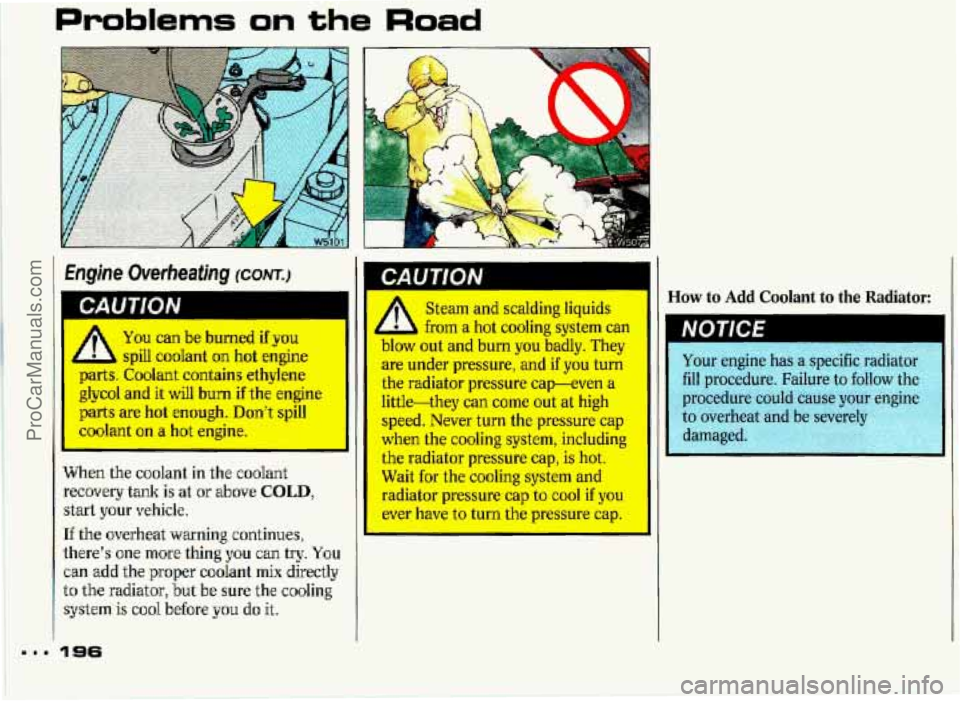
I
Problems on the Road
You can be burned ifp~
l spill coolant on hot engine
parts. Coolant contains ethylene
glycol
and it will bum if the engine
parts are hot enough. Don't spill
coolant on a hat engine.
When the coolant in the coolant
recovery tank
is at or above COLD,
start your vehicle.
If the overheat warning continues,
there's one more
thing you can try. You
can add the proper coolant mix directly
to
the radiator, but be sure the cooling
system is cool before you do it.
'I 96
A Steam and scalding liquids
L from a hot cooling system dm
b.,,v out and burn you badly. They
are under pressure, and if you turn
the radiator pressure cap-even a
little-they can come out at high
speed. Never turn the pressure cap
when the cooling system, including
the radiator pressure cap, is hot.
Wait for the cooling system and
radiator pressure cap tu cool if you
ever have to turn the pressure-cap.
How to Add Coolant to the Radiator:
Your engine has a specific radiator
fill procedure. Failure
to follow the
procedure
could cause your engine
to overheat and be severely
damaged.
ProCarManuals.com
Page 198 of 338
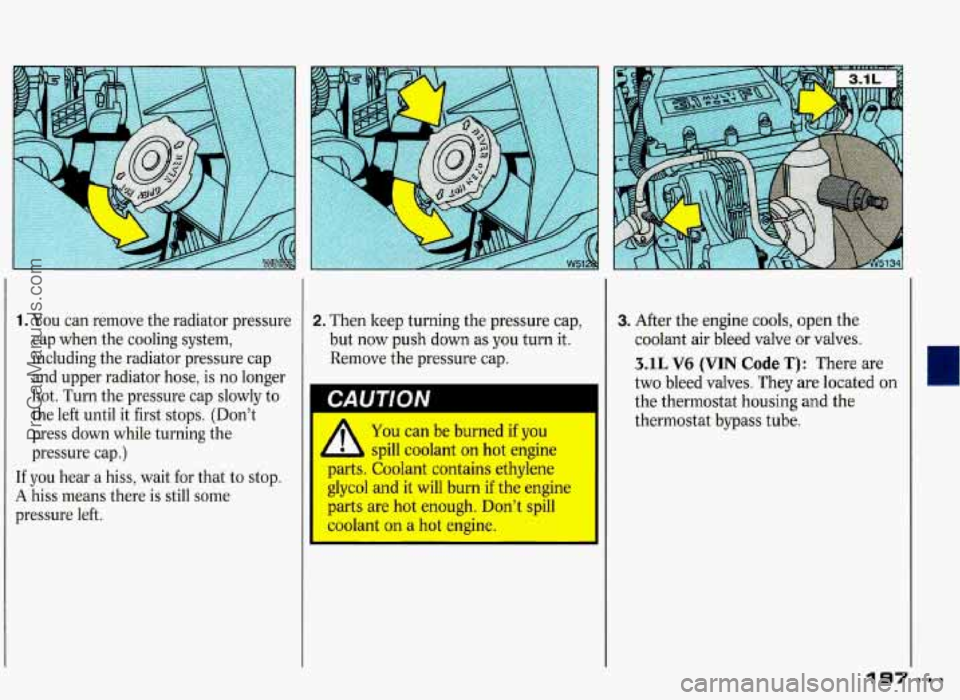
1. You can remove the radiator pressure
cap when the cooling system,
including the radiator pressure cap
and upper radiator hose, is
no longer
hot. Turn the pressure cap slowly to
the left until it first stops. (Don’t
press down while turning the
pressure cap.)
If you hear a hiss, wait for that to stop.
A hiss means there is still some
pressure left.
2. Then keep turning the pressure cap,
but now push down as you turn it.
Remove
the pressure cap.
I CAUTION
I A You can be burned if you
spill
coolant on hot engine
pa La. Coolant contains ethylene
glycol and it will burn if the engine
parts
are hot enough. Don’t spill
coolant on a hot engine.
3. After the engine cools, open the
coolant air bleed valve or valves.
3.1L V6 (VIN Code T): There are
two bleed valves. They
are located on
the thermostat housing and the
thermostat bypass tube.
ProCarManuals.com
Page 200 of 338
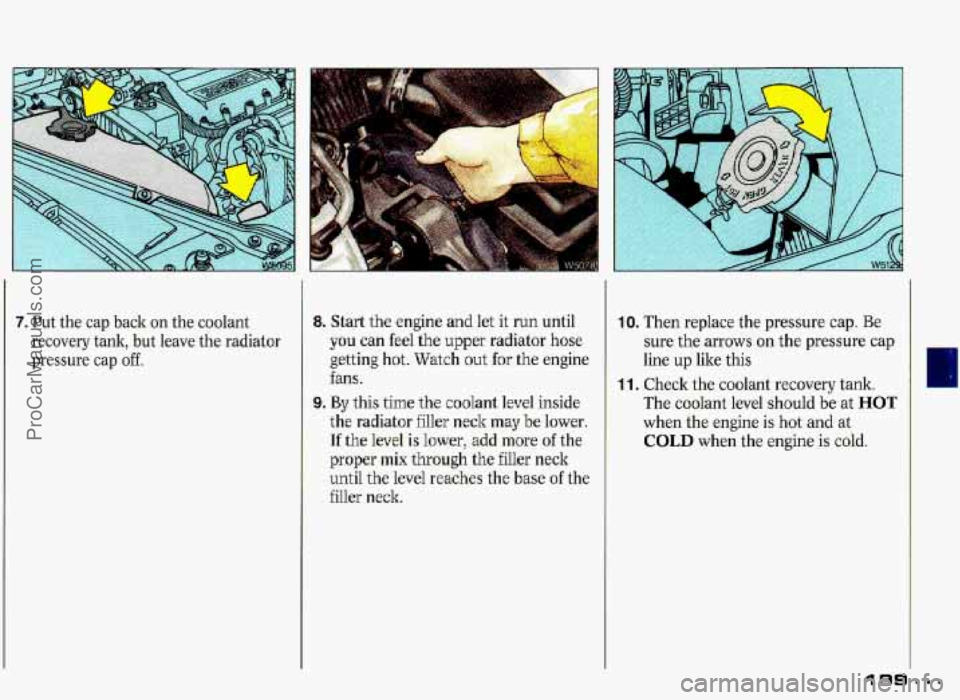
7. Put the cap back on the coolant 8. Start the engine and let it run until
recovery tank, but leave the radiator
you can feel the upper radiator hose
pressure cap off. getting hot.
Watch out for the engine
fans.
9. By this time the coolant level inside
the radiator filler neck
may be lower.
If the level is lower, add more of the
proper
mix through the filler neck
until the level reaches the base of the
filler neck.
10. Then replace the pressure cap. Be
sure the arrows
on the pressure cap ~
line up like this
11. Check the coolant recovery tank.
The coolant level should be at
HOT
when the engine is hot and at
COLD when the engine is cold.
ISS...
ProCarManuals.com
Page 219 of 338
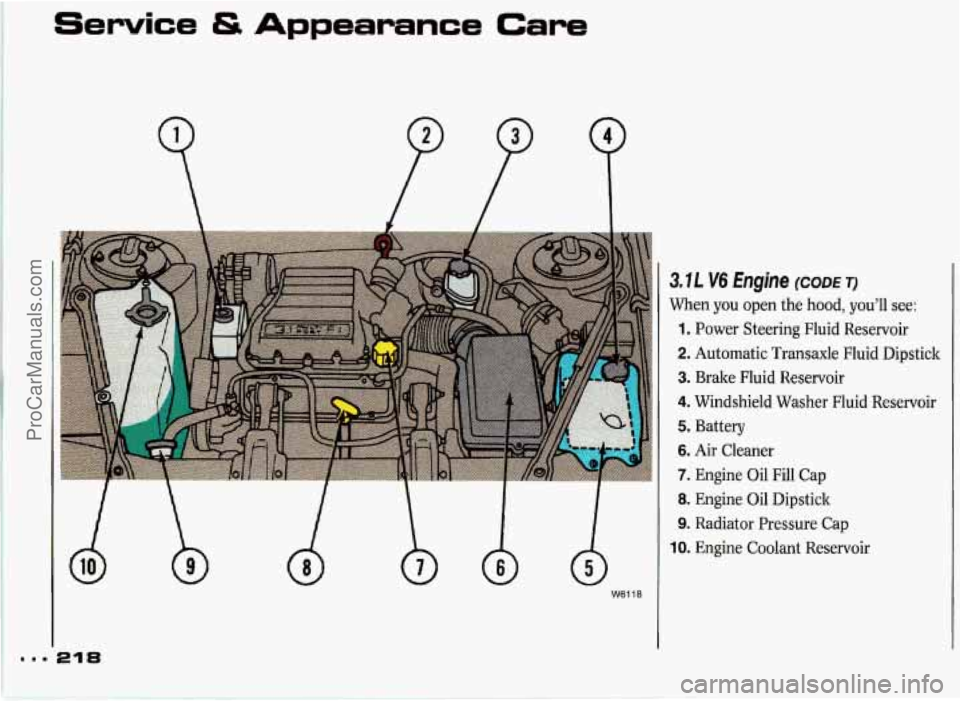
Service & Appearance Care
21%
W6118
3.IL V6 Engine (CODE T)
When you open the hood, you’ll see:
1. Power Steering Fluid Reservoir
2. Automatic Transaxle Fluid Dipstick
3. Brake Fluid Reservoir
4. Windshield Washer Fluid Reservoir
5. Battery
6. Air Cleaner
7. Engine Oil Fill Cap
8. Engine Oil Dipstick
9. Radiator Pressure Cap
10. Engine Coolant Reservoir
ProCarManuals.com
Page 220 of 338
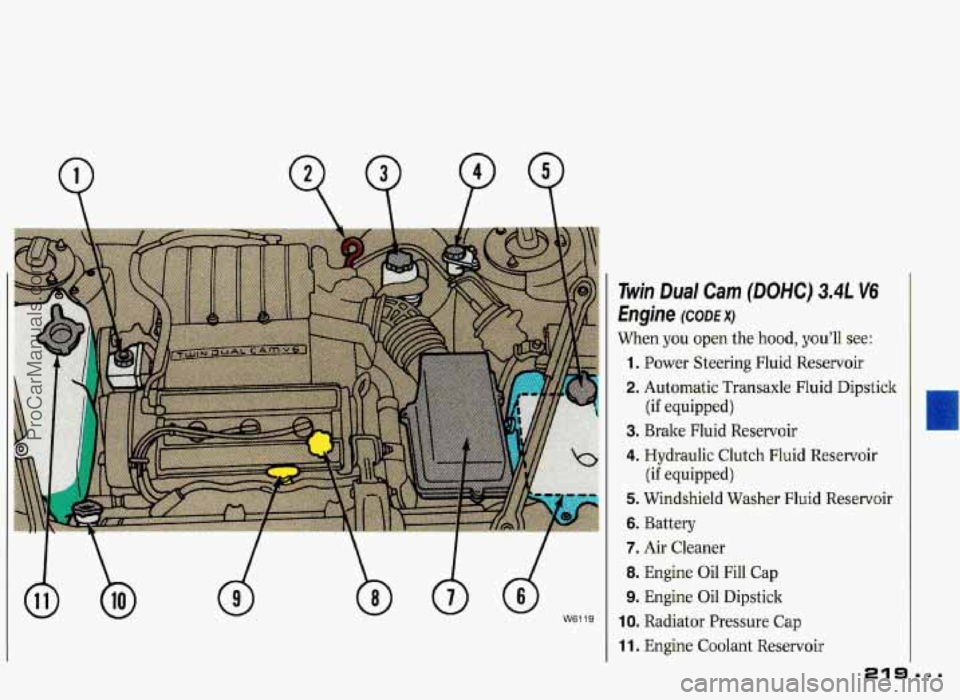
d
Twin Dual Cam (DOHC) 3.4L V6
hgne (CODE x)
When you open the hood, you’ll see:
1. Power Steering Fluid Reservoir
2. Automatic Transaxle Fluid Dipstick
3. Brake Fluid Reservoir
4. Hydraulic Clutch Fluid Reservoir
5. Windshield Washer Fluid Reservoir
6. Battery
7. Air Cleaner
8. Engine Oil Fill Cap
9. Engine Oil Dipstick
IO. Radiator Pressure Cap
11. Engine Coolant Reservoir
(if equipped)
(if equipped)
ProCarManuals.com
Page 231 of 338
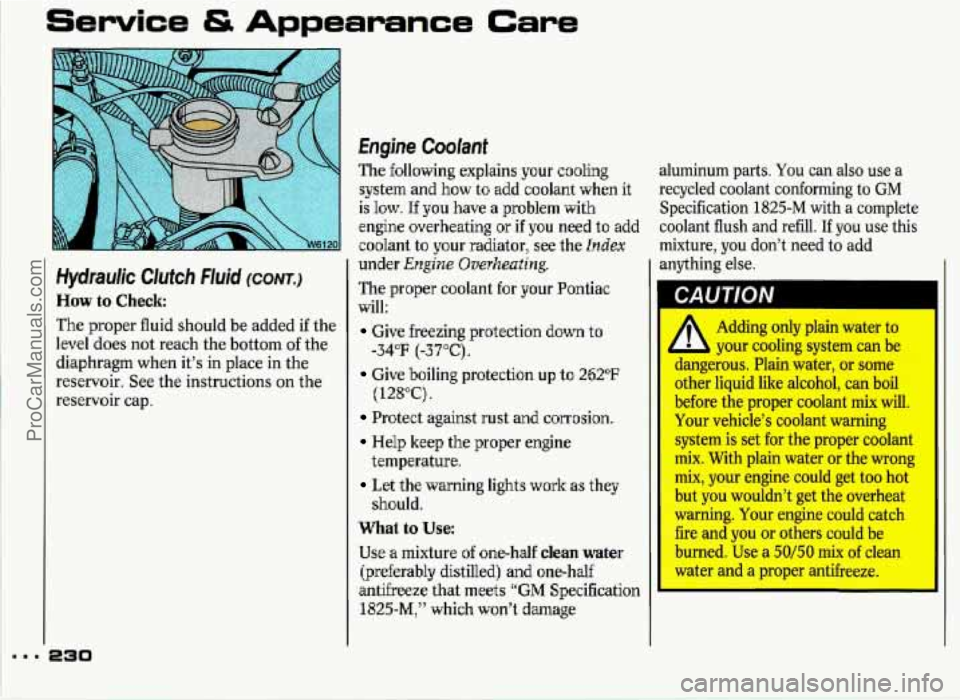
Service & Appearance Cam
Hydraulic Clutch Fluid (CONTJ
How to Check
The proper fluid should be added if the
level does not reach the bottom
of the
diaphragm when it’s in place in the
reservoir. See the instructions on the
reservoir cap.
230
Engine Coolant
The following explains your cooling
system and
how to add coolant when it
is low. If you have a problem with
engine overheating or
if you need to add
coolant to your radiator, see the Index
under Engine Overheuling.
The proper coolant for your Pontia’c
will:
Give freezing protection do;wn to
Give boiling protection up to 262°F
Protect against rust and corrosion.
Help keep the proper engine
Let the warning lights work as they
What to Use:
Use a mixture of one-half dean water
(preferably distilled) and one-half
antifreeze that meets
“GM Specification
1825-M,” which won’t darnage
-34°F (-3 7 “C) .
(12S°C).
temperature.
should.
aluminum parts. You can also use a
recycled coolant conforming to
GM
Specification 1825-M with a complete
coolant flush and refill. If you use this
mixture, you don’t need to add
anything else.
Adding only plain water
to
your cooling system can be
dangerous. Plain water, or some
other liquid like alcohol, can boil
before the proper coolant mix will.
Your vehicle’s coolant warning
system is set for the proper coolant
mix. With plain water or the wrong
mix, your engine could get
too hot
but you wouldn’t get the overheat
warning. Your engine could catch
fire and you or others could be
burned. Use a
50/50 mix of clean
water and
a Droner antifreeze.
ProCarManuals.com
Page 233 of 338
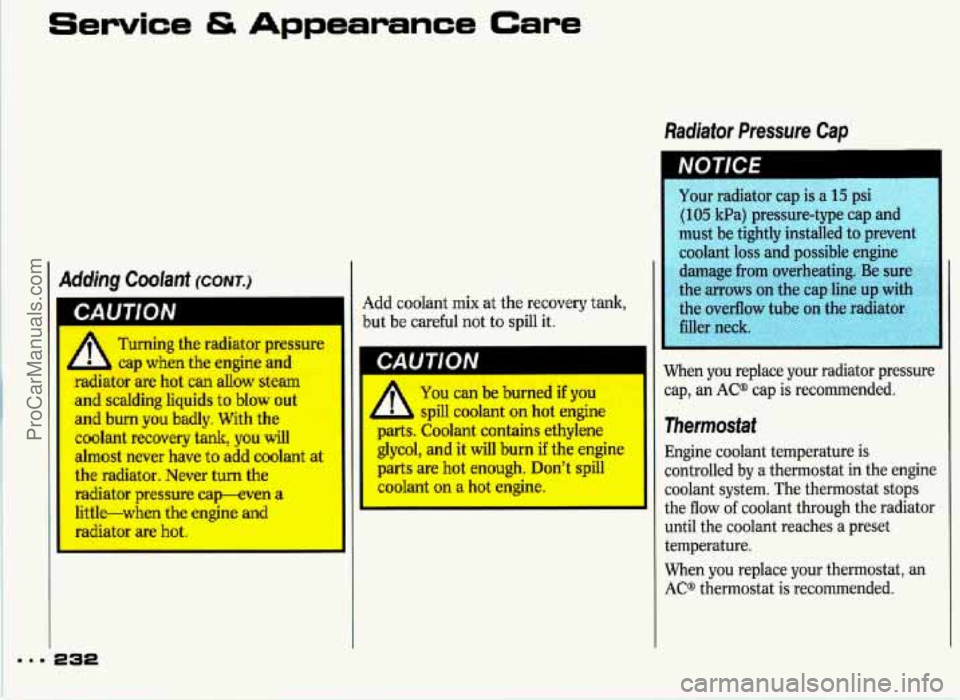
Service & Appearance Care
Turning the radisiitor pressure
1 b cap when the en& and
radiator am hat can daw steam
and scalding liquids to blow out
and burn you badly. With the
almost never have to add coolant at
the radiator. Never turn the
radiator pressure mp-evtm a
I.lttle-whm the engine and
coolant recoverg tadq lyou will
Add coolant mix at the recovery tank,
but be careful not to spill it.
Radiator Pressure Cap
Dm
Your radiator cap is a 15 psi
(105 kPa) pressure-type cap and
must be tightly installed to prevent
coolant loss and possible engine
damage
from overheating. Be sure
the arrows on the cap line up
with
the overflow tube on the radiator
filler neck.
I I'
11 CAUTION
You can be burned if you
I spill coolant on hot engine I
,~rts. Coolant contains ethylene
glycol, and it will burn if the engine
parts are hot enough.
Don't spill
coolant on a hot engine.
I I When you replace your radiator pressure
I
cap, an AC@ cap is recommended.
Thermostat
Engine coolant temperature is
controlled by a thermostat in the engine
coolant system. The thermostat stops
the
flow of coolant through the radiator
until the coolant reaches a preset
temperature.
When you replace your thermostat, an
AC@ thermostat is recommended.
ProCarManuals.com
Page 298 of 338
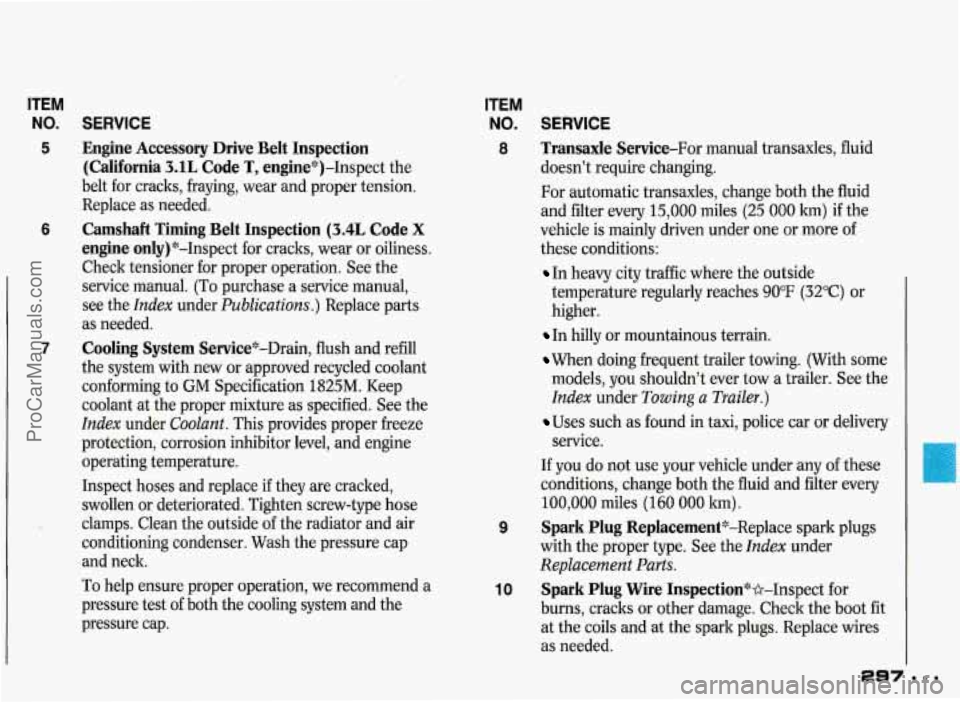
ITEM
NO. SERVICE
ITEM NO. SERVICE
5
6
Engine
Accessory Drive Belt Inspection
(California
3.1L Code T, engine*)-Inspect the
belt for cracks, fraying, wear and proper tension.
Replace as needed,
Camshaft Timing Belt Inspection
(3.4L Code X
engine only)*-Inspect for cracks, wear or oiliness.
Check tensioner for proper operation. See the
service manual. (To purchase a service manual,
see the
Index under Publications.) Replace parts
as needed.
7 Cooling System Service*-Drain, flush and refill
the system with new or approved recycled coolant
conforming to
GM Specification 1825111. Keep
coolant at the proper mixture as specified. See the
Index under Coolant. This provides proper freeze
protection, corrosion inhibitor level, and engine
operating temperature.
Inspect hoses and replace if they are cracked,
swollen or deteriorated. Tighten screw-type hose
. clamps. Clean the outside of the radiator and air
conditioning condenser. Wash the pressure cap
and neck.
To help ensure proper operation, we recommend a
pressure test of both the cooling system and the
pressure cap.
8 Transaxle Service-For manual transaxles, fluid
doesn’t require changing.
For automatic transaxles, change both the fluid
and filter every
15,000 miles (25 000 lun) if the
vehicle is mainly driven under one or more of
these conditions:
In heavy city traffic where the outside
temperature regularly reaches
90°F (32°C) or
higher.
In hilly or mountainous terrain.
9
10
When doing frequent trailer towing. (With some
models,
you shouldn’t ever tow a trailer. See the
Index under Towing a Trailer.)
Uses such as found in taxi, police car or delivery
service.
If you do not use your vehicle under any
of these
conditions, change both the fluid and filter every
100,000 miles (160 000 km).
Spark Plug Replacement *-Replace spark plugs
with the proper type. See the
Index under
Replacement Parts.
Spark Plug Wire Inspection*+Inspect for
burns, cracks
or other damage. Check the boot fit
at the coils and at the spark plugs. Replace wires
as needed.
ProCarManuals.com
Page 332 of 338
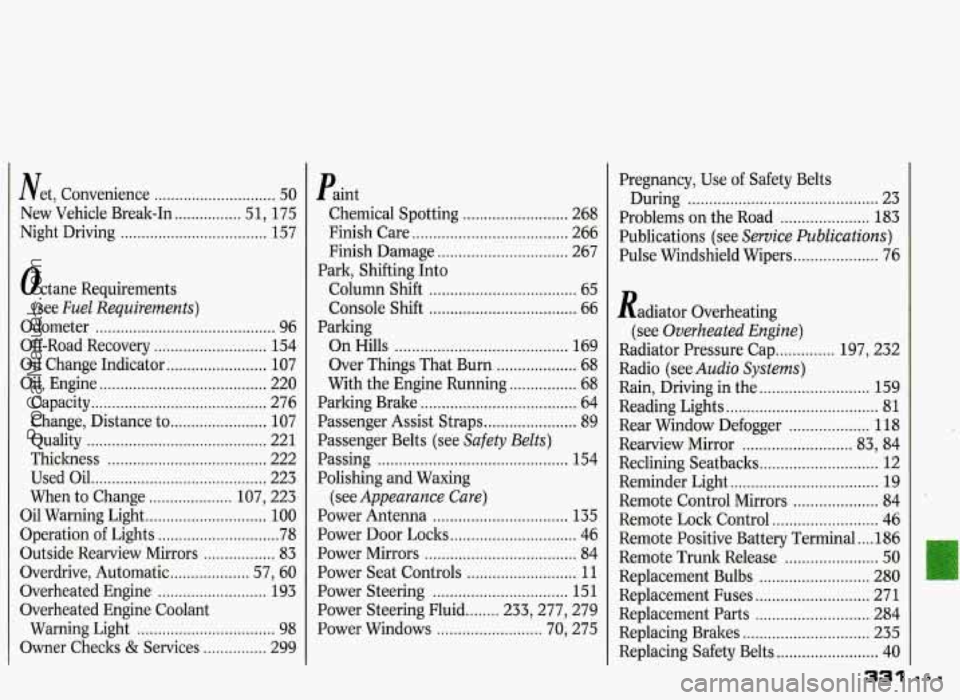
..
Net. Convenience ............................. 50
New Vehicle Break-In ................ 51. 175
Night Driving
................................... 157
Octane Requirements
Odometer
........................................... 96
Off-Road Recovery
........................... 154
Oil Change Indicator
........................ 107
Oil. Engine
........................................ 220
Capacity
.......................................... 276
Change. Distance to
....................... 107
Quality
........................................... 22 1
Thickness ...................................... 222
Used Oil
.......................................... 223
When to Change
.................... 107. 223
Oil Warning Light
............................. 100
Operation
of Lights ............................. 78
Outside Rearview Mirrors ................. 83
Overdrive. Automatic ................... 57. 60
Overheated Engine Coolant Warning Light
................................. 98
Owner Checks
& Services ............... 299
(see
Fuel
Requirements)
Overheated Engine .......................... 193 Paint
Chemical Spotting
......................... 268
Finish Care
..................................... 266
Finish Damage
............................... 267
Column Shift
................................... 65
Console Shift
................................... 66
On Hills ......................................... 169
Over Things That Burn
................... 68
With the Engine Running
................ 68
Parking Brake ..................................... 64
Passenger Assist Straps
...................... 89
Passenger Belts (see Safety Belts)
Passing ............................................. 154
Polishing and Waxing
Power Antenna
................................ 135
Power Door Locks
.............................. 46
Power Mirrors
.................................... 84
Power Seat Controls
.......................... 11
Power Steering ................................ 151
Power Steering Fluid
........ 233.277. 279
Power Windows
......................... 70. 275
Park.
Shifting Into
Parking
(see
Appearance Care)
Pregnancy. Use of Safety Belts
During
............................................. 23
Problems
on the Road ..................... 183
Publications (see Service Publications)
Pulse Windshield Wipers .................... 76
Radiator Overheating
(see
Overheated Engine)
Radiator Pressure Cap .............. 197. 232
Radio (see
Audio Systems)
Rain. Driving in the .......................... 159
Reading Lights
.................................... 81
Rear Window Defogger ................... 118
Rearview Mirror .......................... 83, 84
Reclining Seatbacks
............................ 12
Reminder Light
................................... 19
Remote Control Mirrors .................... 84
Remote Lock Control
......................... 46
Remote Positive Battery Terminal
.... 186
Remote Trunk Release
...................... 50
Replacement Bulbs .......................... 280
Replacement Fuses
........................... 271
Replacement Parts
........................... 284
Replacing Brakes
.............................. 235
Replacing Safety Belts
........................ 40
.
ProCarManuals.com